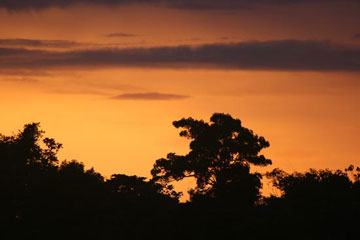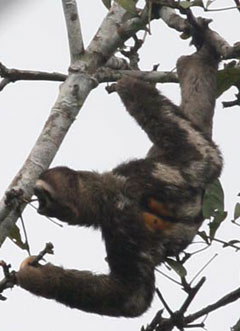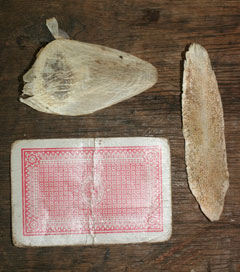Special to mongabay.com: Wilderness Classroom: Expedition 2006 The following is an update from The Wilderness Classroom’s expedition to the Peruvian rainforest. You can follow their adventures at wildernessclassroom.com |
The Amazon: Fisherman’s paradise
The Wilderness Classroom Organization
May 2, 2006
Update 15: Dave
This morning, I joined Warren and our new guide, Ramon, for a paddle in search of animals. At Lake El Dorado, you do not have to go far to find animals. It seemed like everywhere we looked we found something new to look at.
A Pink River Dolphin surfaced to get a closer look at us. It almost scared me our of the boat when it took a loud breath only 10 feet behind out boat. A few more paddle strokes down a narrow canal revealed a sloth eating breakfast in the tree tops, while a troop of Saddle Backed Tamarinds chirped loudly to let the other animals know that we had arrived.
Around the next bend, we saw sidenecked turtles basking on a log. Giant turkey-like birds, called horned screamers, sat in the trees. Hoatzins, Macaws, and turkey vultures circled over head.
We are surrounded by so much life here in the rainforest. I began to wonder what allows so many different plants and animals to survive here.
It was almost 1:00 PM when we returned to the ranger station. It felt like the sun’s rays were burning right through the sunscreen that I constantly slather all over my body. “That’s it!” I yelled toward the sun. Warren and Ramon looked at me blankly. But then it dawned on me that the sun is one of the main reasons all of these plants and animals can live in the rainforest.
The sun provides light that the thousands of species of plants use for Photosynthesis. In turn, many animals find food and shelter in the plants that grow. Plus, because the Amazon is so close to the Equator, the sun keeps the Amazon rainforest warm throughout the year, perfect for growing and surviving.
 A beautiful sunset provides the perfect ending to our first day at Lake El Dorado |
Paiche for all – Patrick
The paiche, or Arapaima, is the largest freshwater fish in the world. They typically grow to be over ten feet long and weigh 350 pounds! It is unbelievable to think that the locals catch these monsters with nothing but their nets and then plop them into their dugout canoes.
The volunteer park rangers, or guards, on Lake El Dorado have worked for 12 years to protect the Pacaya Samiria Preserve. The rangers have many jobs, but their main job is to protect the once plentiful arapaima.
Their conservation efforts are paying off, because the local population of Arapaima is rebounding slowly, but steadily increasing in this location. It is great to see a conservation program working on Lake El Dorado. As a reward for their efforts, the guards are able to catch a certain number of fish for their community and to sell.
 This sloth was pigging out on its favorite food, leaves. |
Arapaima are specially adapted for life in floodplain lakes. When water levels drop and temperatures rise in the dry season, most fish leave the lake for the river. For the fishes stuck in the land-locked lake, an arapaima is their worst nightmare. A fast, agile swimmer, the arapaima gorges itself on fish during the low-water season. The arapaima is able to store enough energy to keep it alive when the fish are dispersed throughout the forest during the high-water season.
Since Arapaima breathe air instead of water, it is able to thrive at a time when other fishes struggle for oxygen. Instead of gills, the arapaima has an air bladder, which it uses for buoyancy. The air bladder functions similarly to our lungs: it is filled through the mouth much like the way many mammals breathe.
Humans have always hunted arapaima for its incredibly tasty meat. People also use the fish’s rough scales and tongue for sanding tools.
Due to heavy commercial fishing, the arapiama population is seriously threatened. We can only hope that people in other areas of Amazonia have made attempts to observe the arapaima population in their floodplain lakes and do what it takes to keep them from extinction.
 At the top, an arapaima scale, on the right, the tongue. Both are used as tools to file and sand. |
Fishing for a Living – Anna
If you lived in the rainforest, finding work as a banker, a doctor, or even a school teacher might be challenging. You could, however, make a decent living as a fisherman. For most people in this area, fishing is one of the only sources of income.
Our friend, Don Ramon, who guided us to Lake El Dorado, fishes for food and for money. From his work, he makes about 3000 soles per year, or 1000 dollars. That’s enough money to make ends meet for his family, since they don’t pay a mortgage, rent, or bills.
Don Ramon, along with 15 other men from his community, fish for two kinds of fish at Lake El Dorado: Paiche (Arapaima) and Arawana. They also collect and sell turtle eggs. Because the arapaima and arawana were once endangered, the fishermen are only allowed to catch a certain amount of fish each year. In exchange for being able to catch the fish, the men must volunteer at the ranger stations in the reserve. When they are volunteering, the fishermen help monitor fish populations and keep illegal fisherman out of the area.
Last year, the sixteen men caught 24 arapaima. That doesn’t seem like very many, but when each fish weighs over 160 kilograms, or 350 pounds, that’s all they need. If they catch a paiche that weighs any less, they let it go. The fish are caught in nets, canoed down the river, and then carried on foot for several miles back to the town of Manco Capac. There, the fish are filleted, put on ice, and sold for about 5 soles per kilogram. Last year the group sold over 2 tons of arapaima. (Note: $1 US equals 3.32 Peruvian soles)
The arawana is caught in a much different way. Young arawana is more valuable than the older fish. The male arawana carry the young fish in their mouths to protect them from predators. When Don Ramon catches an arawana, he opens the mouth of the huge fish, takes the young arawana, and then releases the adult back into the water. The young arawana are then farm-raised until they are large enough to sell in Iquitos and Lima. They are sold alive, since arawana are mostly sold for aquariums all over the world. Last year he and his friends harvested 25,000 arawanas, farm-raised them, and then sold them for three soles each.
In the Pacaya Samiria National Reserve, conservationists are working with local fisherman to fish sustainably. Because of this partnership, the once endangered fish are now thriving and Don Ramon and other fishermen can bring home food and money to their families.
Daily Dilemma #15 Survival of the fittest?
As we travel through many communities in the rainforest, we have found that most people earn money by fishing. They use huge nets and catch hundreds of fish, and then sell them in some of the larger towns: smoked, salted, dried, or fresh. That is a great way to make a living, however, it doesn’t seem so great to us when we see fish like the endangered Arapaima and Arawana being mass harvested and sold. Then again, we are saddened by the poverty that we see as we travel through these rural rainforest villages. It seems like the poverty would only get worse if the people couldn’t profit off of fishing.
Within the Pacaya Samiria National Reserve, fishing is regulated by scientists and conservationists. This is not the case in the rest of this massive rainforest, however, and fish populations are suffering.
This is quite a dilemma, because fishing is one of the only sources of income for most people in the rainforest. If they didn’t fish for the Arapaima and Arawana, they might suffer without food and money. The communities already have very little money, and if they lose their largest source of income, fishing, how will they survive? But then again, if people continue to fish for these valuable animals, the paiche, arawana, and turtles will become extinct.
A great solution would be to put conservationists in every area of the rainforest to monitor fishing, like they do at Lake El Dorado. Unfortunately, this solution isn’t very feasible due to lack of money and resources in the area. Do you have any thoughts or ideas on how to handle this delicate situation?
We are definitely stumped on this one!
Track the adventurers at wildernessclassroom.com